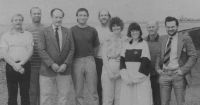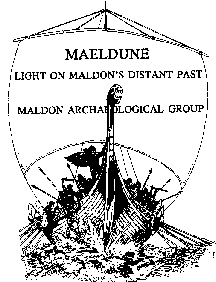
|
MAELDUNELIGHT ON MALDON'S DISTANT PASTMALDON ARCHAEOLOGICAL GROUPRegistered Charity No.285387 |
ISBN 0 9511948 1 X. - Copyright Maldon Archaeological Group 1992.
|
The production of the book was sponsored by the following organisations:
|

The Maeldune Team |
Dedication:
To Garth who in recent years has done more toward the archaeology and history of Maldon than anyone else we know.
CONTENTS

|
FOREWORD
The celebration in 1991 of the 1000th anniversary of the Battle of Maldon shone a light on an event which, however once significant in the nation's history, had long since slipped into the shadows for most Maldonians. This is the value of such occasions. They reawaken, refocus attention, provide new opportunities to learn or relearn detail, to brush off the dust.
Now that the year of celebration is over, Maldon will resume the daily life of a small and pleasant Essex town. But the achievements will remain; a fine new commemorative embroidery and a medieval garden to grace the town; at least two collections of scholarly studies to lay the groundwork for the next millennium of research into the beautiful but ultimately enigmatic poem which records the story of the Battle; and this present book, compiled by the Maldon Archaeological Group to build upon the reawakened pride and interest of Maldon people in their town's origins and past.
In these pages, readers will find a clear, readable and well founded account of the Battle and the questions which surround it. They will find much more beside. It reaches back into the earliest ages of human settlement in the area, some 10,000 years ago, and recounts, as best it can be recounted, the development of the place which was to grow into the town of Maldon we know today. The evidence remains scant, but it is a tribute to the authors that they have carefully used each piece to advantage, fitting it deftly into a simple and succinct account of what is known of the events and background of national and regional life at the time, and thereby opening our eyes in a way which many weightier volumes fail to do.
Moreover there is also recorded here, between the lines, the remarkable record of achievement of the Maldon Archaeological Group itself. Since its formation in 1977, the Group has, it will be clear to anyone reading these pages, played a substantial role in unearthing the evidence which forms the backbone to this story. Ever vigilant for opportunities, the Group's activities - in excavating, in field-walking, in analysing the evidence of other excavations and written sources - have, for 15 years, been a probe, constantly seeking to advance our knowledge of Maldon's past. And long may it be so, for a town's self-esteem rests on its achievements past and present and the work of Maldon Archaeological Group - not least this book itself - in unveiling and explaining the past, is a noteworthy contribution to the life of Maldon today.
Victor Gray - Essex County Archivist - March 1992
INTRODUCTION
'Have you found anything good?' ............
This is by far the most common question asked by visitors to our archaeological excavations. It is invariably posed in terms of treasure such as gold and silver so to be shown a few holes here, a shallow trench there and perhaps a few bits of mud encrusted pottery is likely to be a severe disappointment. It is true that, occasionally, slightly more visually exciting finds are made but for M.A.G., alas, no spectacular hoards to present to an envious world. However, it is those seemingly insignificant undulations in the soil and the pieces of pottery that form much of the basis of our knowledge of Maldon's early history. To an archaeologist, they are genuine treasure. To members of M.A.G., what they have discovered in the soil forms an important part of this book which seeks to trace the history of one of England's most ancient towns from pre-historic times to Domesday.
M.A.G.'s decision to launch into print was prompted by the millennium of the Battle of Maldon. Although much has been written on the subject of the battle, this book attempts to do more. The battle is set in the context both of chronological history and of events outside the narrow confines of Maldon and Essex. It draws, not only on the writings of experts, many of whom have spent a lifetime in historical study, but also on the local knowledge and amateur enthusiasm without which our knowledge of Maldon would be sadly deficient, and without which this book would not have been produced.
Although there has been much written about Maldon, this is the first comprehensive account of its first thousand years and more of its existence. The story begins at the dawn of civilisation when man first emerged from the world of ice and mammoths. Stone Age, Bronze Age and Iron Age all left their mark, however faint, on the area. The conquest and ordered society of the Romans was succeeded by the confusion of Saxon invasion from which slowly emerged a rich and fascinating civilisation. Maldon was to play a dramatic role, according to the annals of the time, when that civilisation was challenged and, for a time, overwhelmed by the Viking invaders. For a brief moment Byrhtnoth made Maldon the centre of the political affairs of the time. For many scholars throughout the world, however, that fame still lives on through the words of the anonymous poet of the Battle of Maldon.
Although Maldon's fame was to be short lived, it clearly remained, according to that masterpiece of Norman administrative genius, the Domesday Book, a town of importance, second in Essex only to Colchester.
Such is the outline of the story which this book presents. It is written in the knowledge that it can never be the final word and that further discoveries will alter perspectives, perhaps end old controversies only to re-open new ones. However, MAG hopes that the reader will agree that treasure lies in more than just the conventional kind.

|
Sections of mammoth tusks have been discovered in local gravel pits. |
| Mealdune Contents | Maldon Archaeological Reports Home | Next section..... |